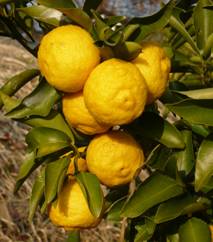Temperature drops down day by day and the winter chill becomes severe. Well, it is not surprising because the winter solstice falls on upcoming Sunday, December 22nd. The sun’s maximum elevation gets the lowest level in the Northern Hemisphere, which gives the shortest daytime and the longest nighttime.
After the winter solstice, the elevation of the sun starts to increase. For that reason, the winter solstice is also called “return of spring,” “reversing yin to yang,” or “favorable turn of fortune.” It is also considered as a timing of rebirth.
 In Japan, many people have still practiced a traditional custom to take a bath with Yuzu citrus fruits floating in the bathtub on the day of winter solstice believing that it will prevent from catching a cold throughout the year. This belief is based on the features of yuzu turee that it is strong against diseases and has a long life. Also, yuzu juice and skins contain abundant of vitamin C. Hot yuzu bath indeed has great effects on moisturizing our skins. Yuzu fruit has such a refreshing and relaxing fragrance. In addition, it is believed that evil spirits avoid strong scent, so taking a yuzu hot bath before a new year arrives is a meaningful ritual.
In Japan, many people have still practiced a traditional custom to take a bath with Yuzu citrus fruits floating in the bathtub on the day of winter solstice believing that it will prevent from catching a cold throughout the year. This belief is based on the features of yuzu turee that it is strong against diseases and has a long life. Also, yuzu juice and skins contain abundant of vitamin C. Hot yuzu bath indeed has great effects on moisturizing our skins. Yuzu fruit has such a refreshing and relaxing fragrance. In addition, it is believed that evil spirits avoid strong scent, so taking a yuzu hot bath before a new year arrives is a meaningful ritual.
Besides the yuzu hot bath, we have another custom to eat pumpkin on the day of the winter solstice. Back in old days, there were little vegetables available during winter, so people would store pumpkins harvested in summer because pumpkins are rich in nutrients. Also, when the word a pumpkin is described in kanji, Chinese characters, it ends with a rhyme implying fortune. By eating pumpkins on the winter solstice day, we believe we gain much fortune.
The winter solstice is a day to reset ourselves. Why don’t we take a moment to reflect upon ourselves, detox our mind and body, and be ready to have a new year to arrive.
